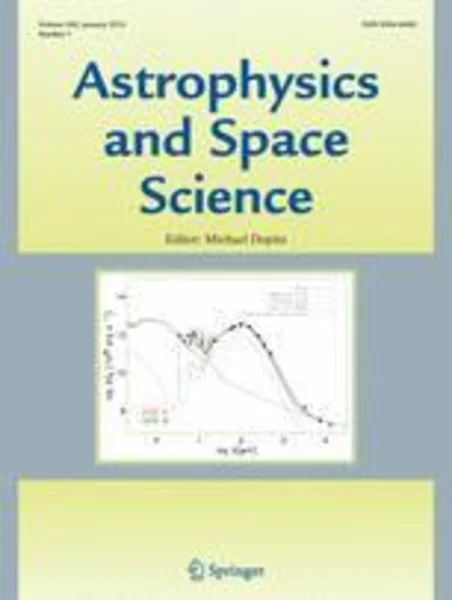-
effective recombination coefficient and solar zenith angle effects on low-latitude d-region ionosphere evaluated from vlf signal amplitude and its time delay during x-ray solar flares
جزئیات بیشتر مقاله- تاریخ ارائه: 1392/07/24
- تاریخ انتشار در تی پی بین: 1392/07/24
- تعداد بازدید: 949
- تعداد پرسش و پاسخ ها: 0
- شماره تماس دبیرخانه رویداد: -
excess solar x-ray radiation during solar flares causes an enhancement of ionization in the ionospheric d-region and hence affects sub-ionospherically propagating vlf signal amplitude and phase. vlf signal amplitude perturbation (δa) and amplitude time delay (δt) (vis-á-vis corresponding x-ray light curve as measured by goes-15) of nwc/19.8 khz signal have been computed for solar flares which is detected by us during jan–sep 2011. the signal is recorded by softpal facility of ierc/icsp, sitapur (22∘ 27′n, 87∘ 45′e), west bengal, india. in first part of the work, using the well known lwpc technique, we simulated the flare induced excess lower ionospheric electron density by amplitude perturbation method. unperturbed d-region electron density is also obtained from simulation and compared with iri-model results. using these simulation results and time delay as key parameters, we calculate the effective electron recombination coefficient (α eff ) at solar flare peak region. our results match with the same obtained by other established models. in the second part, we dealt with the solar zenith angle effect on d-region during flares. we relate this vlf data with the solar x-ray data. we find that the peak of the vlf amplitude occurs later than the time of the x-ray peak for each flare. we investigate this so-called time delay (δt). for the c-class flares we find that there is a direct correspondence between δt of a solar flare and the average solar zenith angle z over the signal propagation path at flare occurrence time. now for deeper analysis, we compute the δt for different local diurnal time slots dt. we find that while the time delay is anti-correlated with the flare peak energy flux ϕ max independent of these time slots, the goodness of fit, as measured by reduced-χ 2, actually worsens as the day progresses. the variation of the z dependence of reduced-χ 2 seems to follow the variation of standard deviation of z along the t x -r x propagation path. in other words, for the flares having almost constant z over the path a tighter anti-correlation between δt and ϕ max was observed.
مقالات جدیدترین رویدادها
-
استفاده از تحلیل اهمیت-عملکرد در ارائه الگوی مدیریت خلاقیت سازمانی و ارائه راهکار جهت بهبود
-
بررسی تاثیر ارزش وجوه نقد مازاد بر ساختار سرمایه شرکت های پذیرفته شده در بورس اوراق بهادار تهران
-
بررسی تأثیر سطح افشای ریسک بر قرارداد بدهی شرکت های پذیرفته شده در بورس اوراق بهادار تهران
-
بررسی تأثیر رتبه بندی اعتباری مبتنی بر مدل امتیاز بازار نوظهور بر نقد شوندگی سهام با تأکید بر خصوصی سازی شرکت ها
-
تأثیر آمیخته بازاریابی پوشاک ایرانی بر تصویر ذهنی مشتری پوشاک ایرانی (هاکوپیان)
-
مقایسه ی استانداردهای اورژانس مصوب وزارت بهداشت، درمان و آموزش پزشکی با اصول نظام ایزو 9001 ویرایش 2000
-
بررسی نیازهای آموزشی بیماران ترخیصی و رضایتمندی آنها از عملکرد آموزشی پرستاران در کرمان
-
نقش تعلق گروهی بر انگیزه پیشرفت تحصیلی دانش آموزان
-
بررسی آسیب های کروموزومی در لنفوسیت های کارکنان اتاق عمل ناشی از استنشاق گازهای بیهوشی به روش آنالیز متافاز
-
application of a force-based state space approach to geometrically nonlinear planar curved beams
مقالات جدیدترین ژورنال ها
-
مدیریت و بررسی افسردگی دانش آموزان دختر مقطع متوسطه دوم در دروان کرونا در شهرستان دزفول
-
مدیریت و بررسی خرد سیاسی در اندیشه ی فردوسی در ادب ایران
-
واکاوی و مدیریت توصیفی قلمدان(جاکلیدی)ضریح در موزه آستان قدس رضوی
-
بررسی تاثیر خلاقیت، دانش و انگیزه کارکنان بر پیشنهادات نوآورانه کارکنان ( مورد مطالعه: هتل های 3 و 4 ستاره استان کرمان)
-
بررسی تاثیر کیفیت سیستم های اطلاعاتی بر تصمیم گیری موفق در شرکتهای تولیدی استان اصفهان (مورد مطالعه: مدیران شرکتهای تولیدی استان اصفهان)
-
عدم شفافیت و اجتناب مالیاتی
-
به کارگیری مهاربندهای کمانش گریز در بهسازی قاب های خمشی فولادی
-
بررسی تأثیر نام تجاری و وفاداری برند در خدمات فن آوری
-
phatics - actual problems of linguistics uzbek research
-
performance of concrete mrf at near-field earthquakes compared to far-field earthquakes




سوال خود را در مورد این مقاله مطرح نمایید :